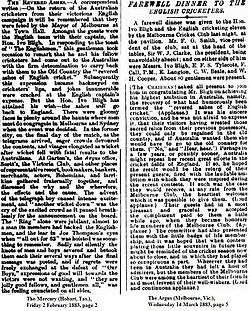English cricket team in Australia in 1882–83
The England national cricket team toured Australia and Ceylon in 1882–83.

The team, captained by Ivo Bligh, was on a quest "to recover those Ashes", a reference to the famous RIP notice that was published in the aftermath of England's defeat by Australia at The Oval during the previous English season.
Originally, three Tests were arranged and England won two of these after losing the first. Although the actual sequence of events has never been completely confirmed, it was after England won the third Test that Ivo Bligh was somehow presented with a small urn which is believed to contain the ashes of a burnt bail. He brought this back to England and it is now the most famous exhibit in the museum at Lord's Cricket Ground. England and Australia have been contesting these mythical Ashes ever since.
The "fourth Test" of this tour was arranged ad hoc after the original series had been completed. Four separate wickets were used in the Test match, one for each innings.[1]
Tour matches
Two/Three-day matches
|
10 – 11 November 1882 |
v |
Match drawn |
| ||
|---|---|---|---|---|---|
| |||||
|
22 – 23 November 1882 |
v |
Match Drawn |
| ||
|---|---|---|---|---|---|
|
Back Creek Ground, Bendigo | |||||
| |||||
|
24 – 25 November 1882 |
v |
Match Drawn |
| ||
|---|---|---|---|---|---|
|
Wattle Flat, Castlemaine | |||||
| |||||
|
6 – 7 December 1882 |
v |
IFW Bligh's XI won by an innings and 15 runs |
| ||
|---|---|---|---|---|---|
|
Albion Ground, West Maitland | |||||
| |||||
|
6 – 7 December 1882 |
v |
Match Drawn |
| ||
|---|---|---|---|---|---|
| |||||
|
11 – 12 December 1882 |
v |
Match Abandoned |
| ||
|---|---|---|---|---|---|
|
Tamworth No 1 Oval, Tamworth | |||||
| |||||
|
26 – 28 December 1882 |
v |
Match Drawn |
| ||
|---|---|---|---|---|---|
| |||||
|
8 – 9 January 1883 |
v |
IFW Bligh's XI won by an innings and 75 runs |
| ||
|---|---|---|---|---|---|
| |||||
|
12 – 13 January 1883 |
v |
IFW Bligh's XI won by 7 wickets |
| ||
|---|---|---|---|---|---|
| |||||
|
2 – 3 February 1883 |
v |
IFW Bligh's XI won by an innings and 154 runs |
| ||
|---|---|---|---|---|---|
| |||||
|
8 – 9 February 1883 |
v |
IFW Bligh's XI won by an innings and 58 runs |
| ||
|---|---|---|---|---|---|
| |||||
First-class Matches
|
17 – 20 November 1882 |
v |
IFW Bligh's XI won by 10 wickets |
| ||
|---|---|---|---|---|---|
| |||||
|
17 – 20 November 1882 |
v |
IFW Bligh's XI won by an innings and 144 runs |
| ||
|---|---|---|---|---|---|
| |||||
|
9 – 12 March 1883 |
v |
Victoria won by an innings and 73 runs |
| ||
|---|---|---|---|---|---|
| |||||
Test matches
First Test
v |
||
- Australia won the toss and elected to bat.
- 31 December 1882 was taken as a rest day.
- Hon. IFW Bligh, CFH Leslie, WW Read, GB Studd, EFS Tylecote and GF Vernon (all Eng) made their Test debuts.
Second Test
v |
||
- England won the toss and elected to bat.
- 21 January was taken as a rest day.
- This was the first Test match to be won by an innings margin.
- W Bates became the first England player to take a Test hat-trick with the first-innings wickets of PS McDonnell, G Giffen and GJ Bonnor. He was also the first player in Test history to score a 50 and take 10 wickets in a match.
Third Test
v |
||
4th Test
v |
||
199/6 (163.1 overs) AC Bannerman 63 AG Steel 3/49 (43 overs) |
- England won the toss and elected to bat.
- 18 February was taken as a rest day.
Players
England was captained by Ivo Bligh and had Edward Tylecote as its specialist wicket-keeper, the other players being Billy Bates, Dick Barlow, Allan Steel, Charles Leslie, Walter Read, Charles Studd, Fred Morley, Billy Barnes, George Vernon and George Studd.
Australia was captained by Billy Murdoch and had Jack Blackham as wicket-keeper. Other players to represent Australia were Billy Midwinter, Alec Bannerman, George Bonnor, Tom Horan, Percy McDonnell, George Giffen, Harry Boyle, Edwin Evans, Hugh Massie, Eugene Palmer, Tom Garrett and Fred Spofforth.
Ceylon
The team used Colombo as a stopover during its long sea voyage and played two matches against local sides in October 1882 that were not first-class. This was the first time that an overseas team visited Ceylon.
|
13 – 14 October 1882 |
Europeans |
v |
Match drawn |
| |
|---|---|---|---|---|---|
| |||||
|
23 October 1882 |
v |
Match drawn |
| ||
|---|---|---|---|---|---|
| |||||
References
- "South Africa's Superman". ESPN Cricinfo. Retrieved 20 February 2019.
External sources
Further reading
- The Wisden Book of Test Cricket 1877–1978 by Bill Frindall
- Chris Harte, A History of Australian Cricket, Andre Deutsch, 1993